《胸中有天地 山川入画来 访画家刘伟》
- 2020-09-19 14:37:42
- 点赞量:8237
- 点击量:200264
- 作者:郝连成 Hao Liancheng
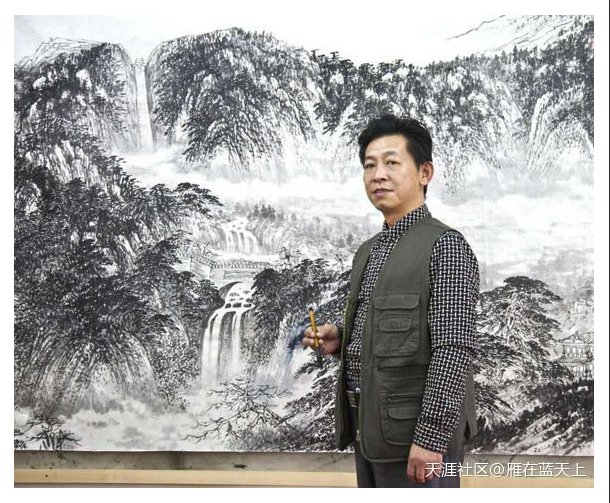
创作《方山神韵》的刘伟
Liu Wei, the creator of Fangshan verve
画了半辈子泰山的刘伟,在读通了杜甫的《望岳》后才真正明白,陆俨少所提出的作画要“四分读书、三分写字、三分作画”是多么有道理。而《望岳》中的一句“岱宗夫如何?“让刘伟整整思考踌躇了好长时间。最后还是爱人的一句:你整天”岱宗夫如何,岱宗夫如何的,你就不能“刘伟夫如何?”一句话讓刘伟顿悟禅机:岱宗夫如何?杜甫问了一千多年,文人画家也写画了一千多年,我刘伟如何能画得与他们不一样?也就是我刘伟夫如何了。这不正是齐白石先生所说:“学我者生,似我者死”吗?
After reading Du Fu's Wangyue, Liu Wei, who has been painting Mount Tai for half of his life, really understood how reasonable Lu Yanshao's "reading, writing, and painting" is proposed by Lu Yanshao. And "Wang Yue" in a sentence: "how about Dai Zongfu? "Liu Wei hesitated for a long time. Last but not least, you can't "how about Liu Weifu?" In a word, let Liu Weidun understand Zen: how about Dai Zongfu? Du Fu asked for more than a thousand years, and literati painters have also written and painted for more than a thousand years. How can I, Liu Wei, paint differently from them? That's what happened to me, Liu Weifu. Isn't this exactly what Mr. Qi Baishi said: "those who learn from me live, and those like me die"?
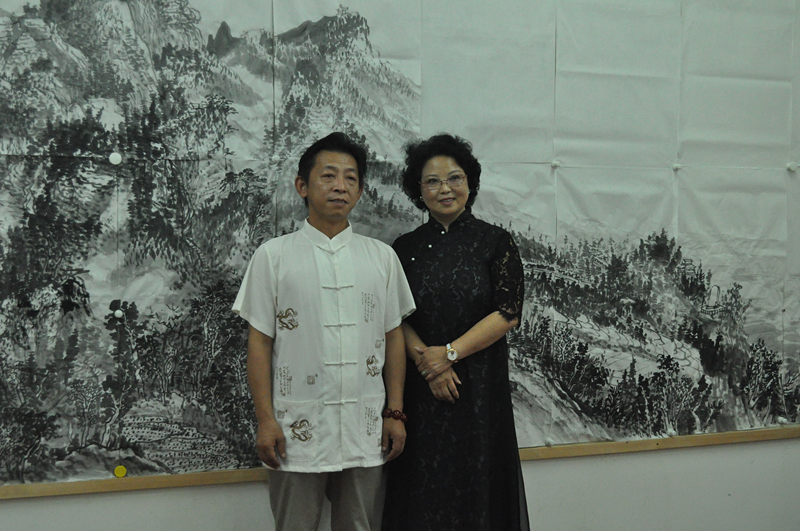
▲画家刘伟与夫人魏平
Painter Liu Wei and his wife Wei Ping
通过领会了《望岳》诗后再画出的泰山也让刘伟画作日臻成熟,也就在那段时间里,刘伟的泰山作品《泰岱旭日》获得了中国美术家协会举办的山水画大奖。以后几年其他作品也连连获奖,是胸中的文化修养使他提升了画技,还是眼前的山水让他动了真情。刘伟有些说不清,但刘伟知道艺术创作需要的是灵感。
After understanding the poem "Wangyue", the painting of Mount Tai has made Liu Wei's paintings more and more mature. During that period, Liu Wei's Taishan painting "taidai rising sun" won the landscape painting award held by China Artists Association. In the next few years, other works also won awards. It was the cultural cultivation in his chest that improved his painting skills, or the landscape in front of him that made him move his true feelings. Liu Wei is a little confused, but he knows that art creation needs inspiration.
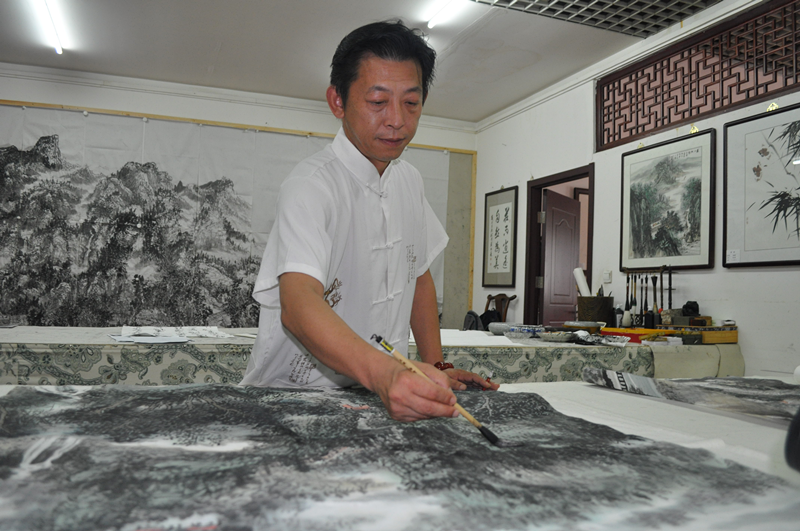
刘伟,号界一,1966年生于济南,自幼酷爱绘画。毕业于山东艺术学院,后在国家画院进修,拜国画大师范扬为师。现为山东画院高级画师,山东泰山书画院副院长、济南市汶都书画院常务副院长,济南市历下名人书画院副院长,济南国画油画研究会副主席。
Liu Wei, No. 1, was born in Jinan in 1966 and loved painting since childhood. He graduated from Shandong Academy of art and studied in the National Academy of painting. He is now a senior painter of Shandong painting academy, vice president of Shandong Taishan calligraphy and painting academy, executive vice president of Jinan Wendu calligraphy and painting academy, vice president of Jinan Lixia celebrity calligraphy and painting academy, and vice chairman of Jinan Chinese painting and oil painting Research Association.
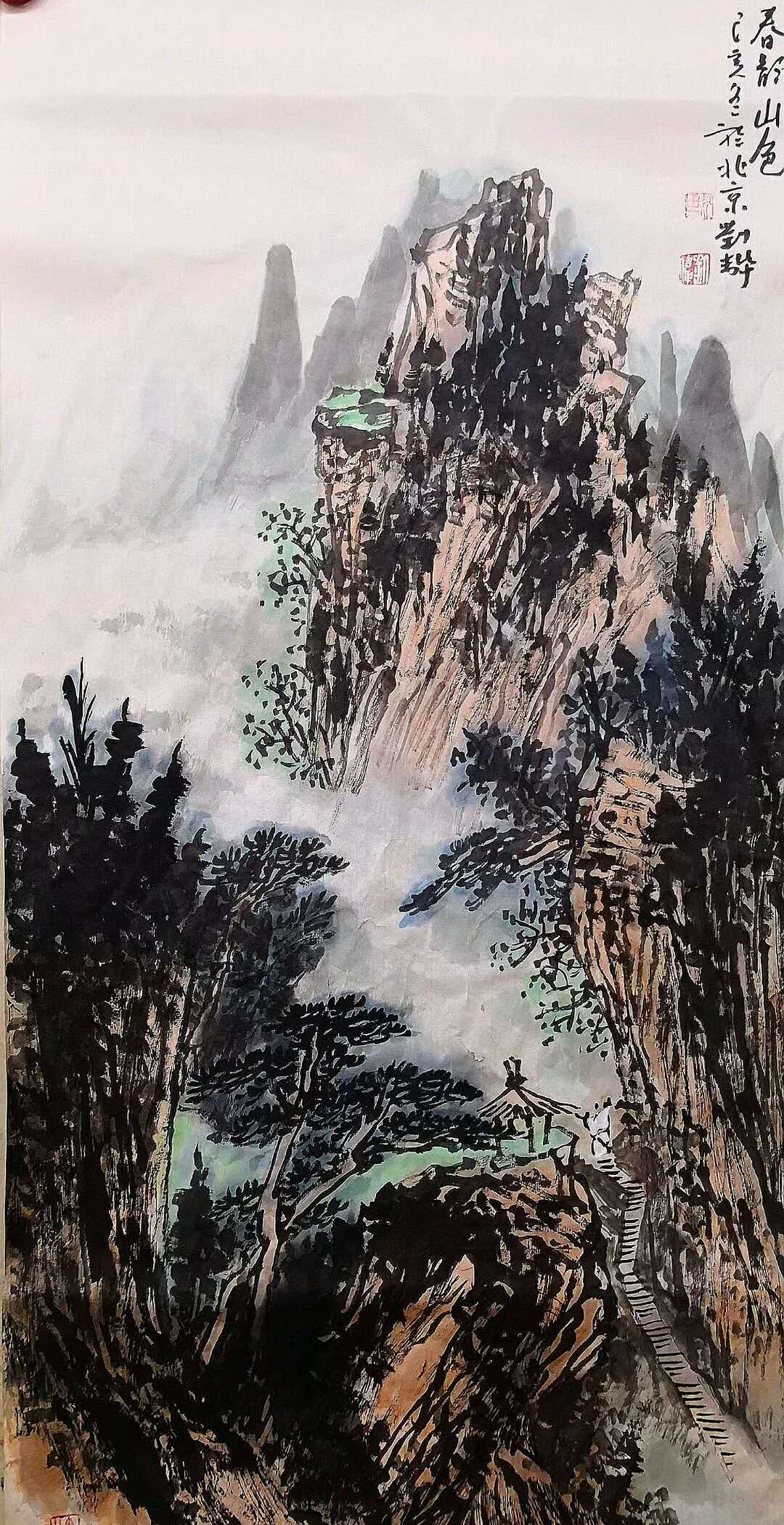
生长在泰山脚下的刘伟深得齐鲁文化的滋养,多年来以 “仁,义、礼、身、智、信”修身,以“道法自然”处世,以“一花一世界”心态去参悟人生。使他的作品里处处透着儒,释,道的柔杂,端庄大气中有虚无飘渺的灵动、现实山水中有种参悟天地的玄机。做画时始终提醒自己要眼中有世界,筆下有自我,他要畫出自己的個性。
Liu Wei, who grew up at the foot of Mount Tai, has been deeply nourished by Qilu culture. For many years, he has cultivated himself by "benevolence, righteousness, propriety, body, wisdom and faith", dealt with the world with "Tao following nature", and understood life with the mentality of "one flower, one world". His works are full of Confucianism, Buddhism and Taoism, dignified atmosphere has illusory intelligence, reality landscape has a kind of mystery to understand the world. When painting, he always reminds himself to have the world in his eyes and his self in his pen. He should draw his own personality.
他的获奖作品泰山,不追求五岳獨尊的殊榮,也不去表現他山峰的突兀和怪石的巉巖。而把表現重點放在了突出泰山居五岳之首而禮賢八方的儒家謙恭有禮的感覺上來。
His award-winning work, Mount Tai, does not pursue the privilege of being the only one of the five mountains, and does not show the abruptness of his peaks and the crags of strange rocks. The emphasis of the performance is to highlight the Confucian sense of humility and courtesy that Mount Tai is the first of the five mountains.
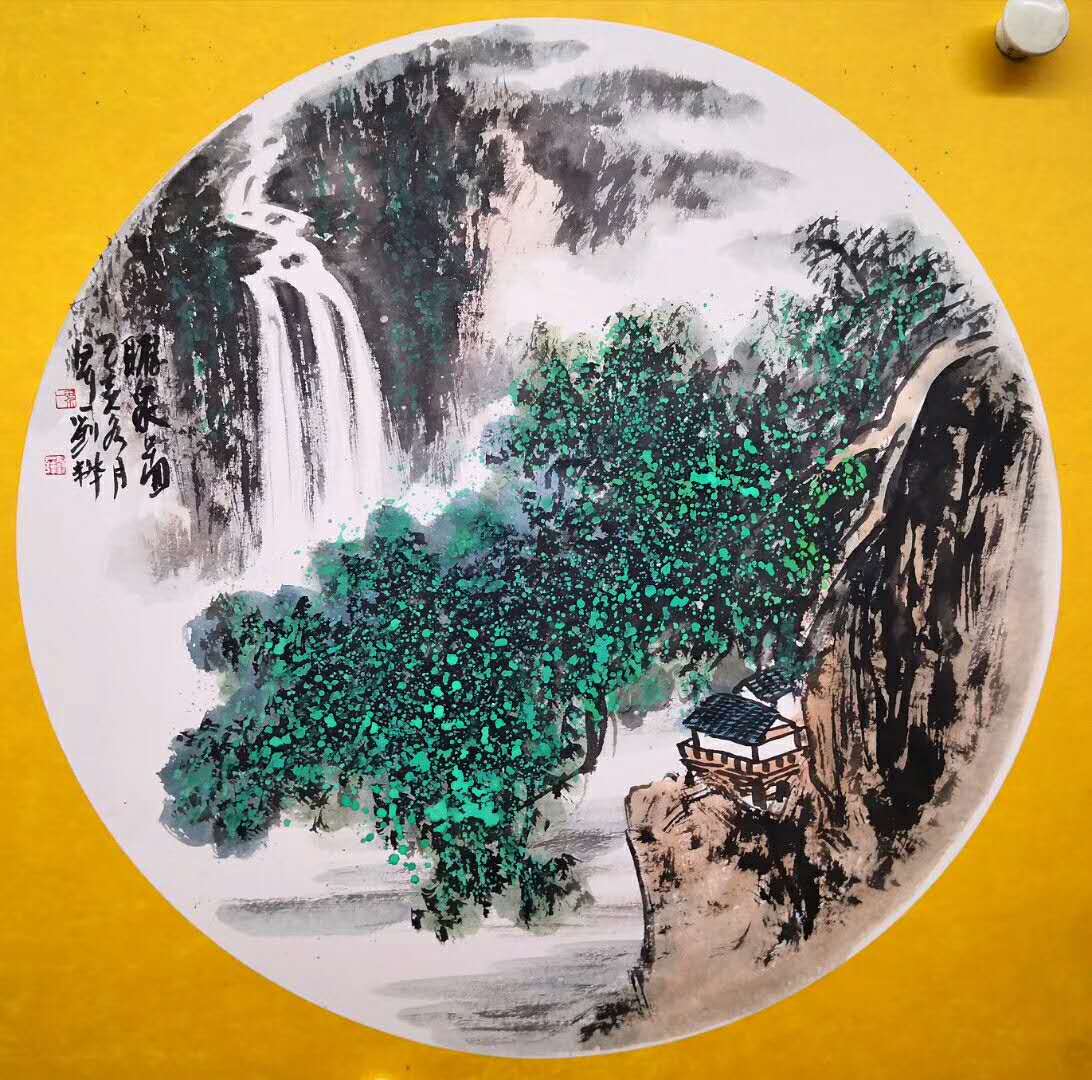
他說,泰山是孔圣人的家郷,泰山的一山一水一草一木都受孔孟思想的熏陶和洗禮,因此才有種種的傳說和兩千五百多塊的碑刻流傳下來。泰山文化的基本精神就是謙虛。不以自己有過兩千多年的封號資歷而傲視天下。 因此,劉偉畫的泰山都有意無意地在構圖上就把泰山的山顶都處理得平緩可攀。甚至有的山峰上還處理成有屋舍和活動的人影,暗示人們泰山的虛懷若谷可容納天下来賓。
He said that Mount Tai is the home of the sage of Confucius. The mountains, rivers, plants and trees of Mount Tai are influenced and baptized by the thoughts of Confucius and Mencius. Therefore, various legends and more than 2500 pieces of inscriptions have been handed down. The basic spirit of Mount Tai culture is modesty. Not to have more than 2000 years of Title qualifications and proud of the world. Therefore, Liu Wei's paintings of Mount Tai have intentionally or unintentionally made the top of Mount Tai gentle and accessible. Even some mountain peaks are treated as figures with houses and activities, implying that the open mindedness of Mount Tai can accommodate guests from all over the world.
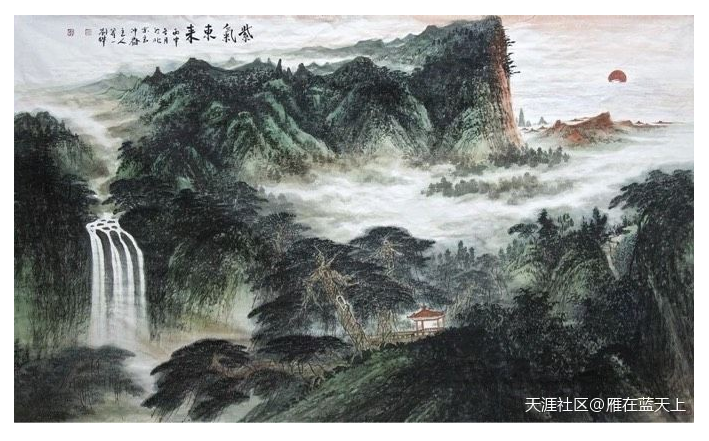
《紫气东来》就是基于这种理念完成的巨幅画作
"Ziqidonglai" is a huge painting based on this concept
作品從構圖開始就突破了過去那種對點、線、面關系的追求,大膽用筆,大塊留白、謹慎用墨。使畫面層次突出,氣韻生動,云飄霧緲,更顯出泰山的蒼遠。小橋流水人家透著山里的安祥和寧靜。遠處東海初升的旭日,正披着艷紅向世界走來。此時的泰山顯得很是平和安靜。 中國美術家協會會員、山東省美术家协会理事谢景勇评价刘伟的作品:能体察出他对导师和前人理论的心摩,对大自然的酷爱,对天地造化的饱游饫看,挖掘造化自然的变幻无穷,在摆脱古人语言束缚上有了很大突破。注意整体感觉与局部趣味关系和宏观驾驭整体态势,而不拘于一点一划的完美无瑕。
From the beginning of composition, the work has broken through the past pursuit of the relationship between point, line and surface, boldly using pen, leaving large pieces of blank and carefully using ink. Make the level of the picture prominent, vivid charm, cloud floating misty, more show the remote Taishan. The small bridge, the flowing water and the people in the mountains are full of peace and tranquility. In the distance, the rising sun in the East China Sea is coming to the world in bright red. At this time, Mount Tai seems very peaceful and quiet. Xie Jingyong, a member of China Artists Association and director of Shandong Artists Association, commented on Liu Wei's works: he could appreciate his meditation on the theories of his tutors and predecessors, his love for nature, his full travel of nature, and his endless changes in nature. He made a great breakthrough in getting rid of the shackles of ancient Chinese language. Pay attention to the relationship between the overall feeling and local interest and the macro control of the overall situation.
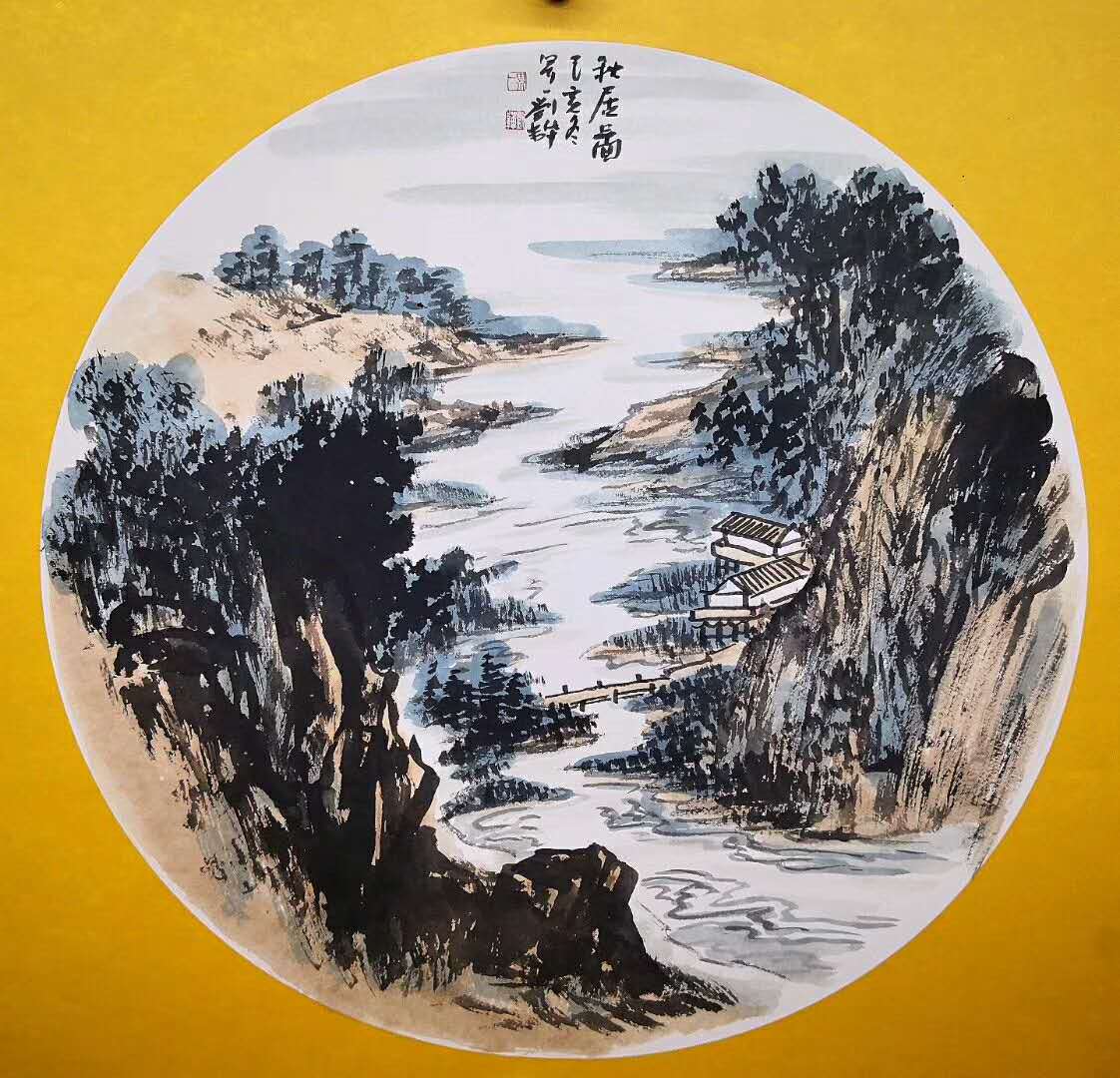
刘伟的作品注入了他对当代老师理论的理解和对古人画风的融合。有段时间,刘伟曾下功夫研究过明清以来各位绘画大师的特点:清初文人画派的四王对刘伟的影响较大,作品一度追求峻秀雅逸、格調高尚,筆法緻密而墨色清潤。后看石涛作画构图新奇,无论是黄山云烟,江南水墨,还是悬崖峭壁,枯树寒鸦,或平远、深远、高远之景,都力求布局新奇,意境翻新。尤其善用“截取法”以特写之景传达深邃之境给刘伟印像最深。后来再看齐白石,潘天寿,徐悲鸿等大师的作品使其更加感觉到绘画的空间已被前辈们堵死,此时刘伟在追求艺术的道路上开始出现困惑,徘徊,无助,甚至有些无耐的感觉。
Liu Wei's works infuse his understanding of contemporary teacher theory and the fusion of ancient painting style. For a period of time, Liu Wei made great efforts to study the characteristics of the masters of painting since the Ming and Qing Dynasties: the four kings of the literati painting school in the early Qing Dynasty had a great influence on Liu Wei. His works once pursued elegance and elegance, noble style, and dense and clear ink. After looking at Shi Tao's paintings, the composition is novel. Whether it is the clouds and smoke of Huangshan Mountain, the ink and wash of the south of the Yangtze River, or the cliffs, withered trees and jackdaws, or the distant, far-reaching and lofty scenery, all strive to create a novel layout and renovate the artistic conception. In particular, he is good at using the "interception method" to convey the depth of the scene to Liu Wei's impression. Later, when he looked at the works of Qi Baishi, Pan Tianshou, Xu Beihong and other masters, he felt that the space of painting had been blocked by his predecessors. At this time, Liu Wei began to feel confused, wandering, helpless and even impatient in his pursuit of art.
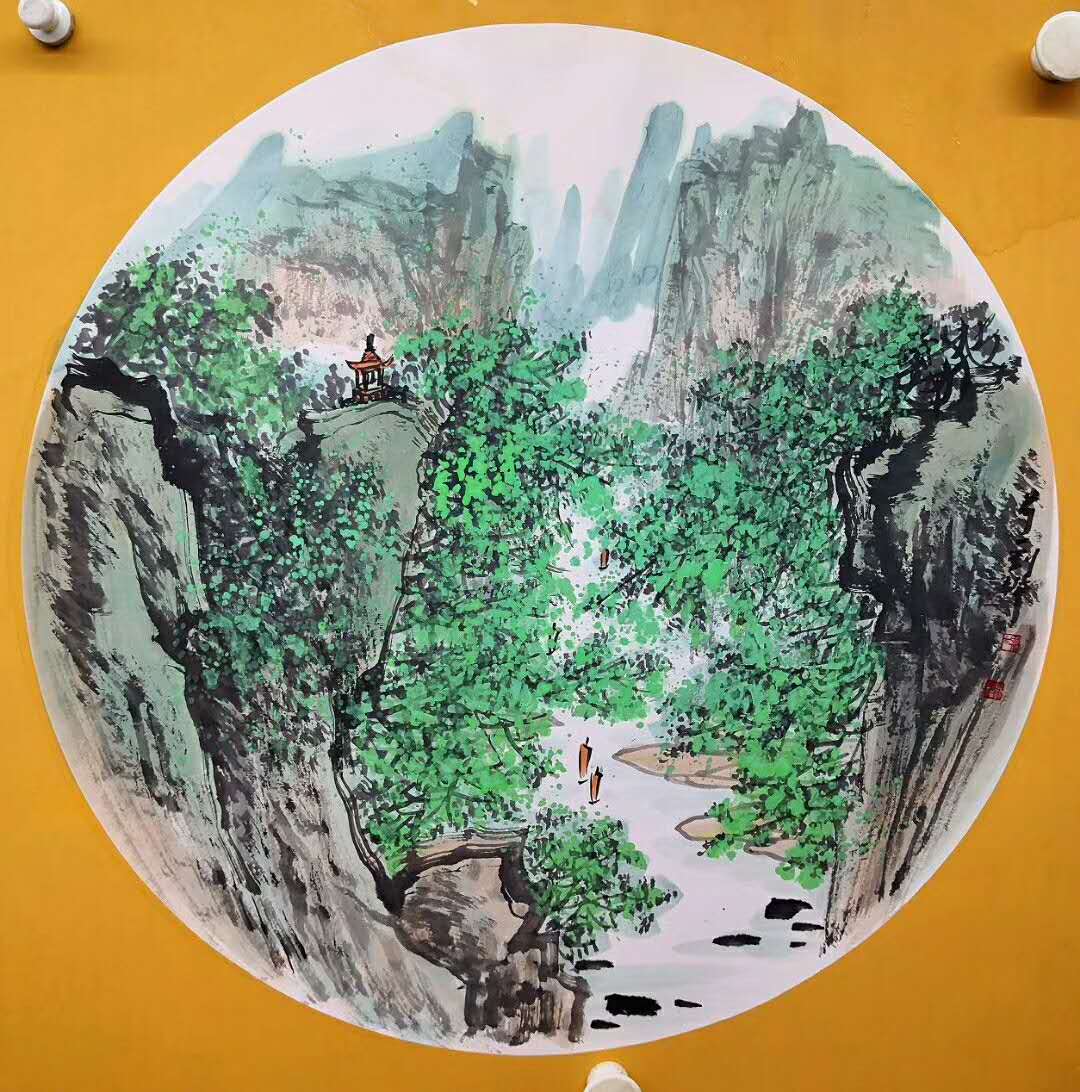
是在中国国家画院和范杨的学习使刘伟彻底地开悟:范杨老师告诉刘伟:你不要羡慕我,更不要模仿我。羡慕就是无知,模仿就是自杀。不要把你学成我,而要把我变成你”。从此刘伟就以一个新的视角来审视绘画。 最后范杨老师告诉刘伟:你在绘画过程中能从“看山是山,看水是水。”到 “看山不是山,看水不是水。”再到“看山还是山,看水还是水。”就成功了,这充满禅意的教导一直让刘伟在画山水的过程中写生不断,创作不断。
It was in the National Academy of painting and Fan Yang's study that made Liu Wei thoroughly enlightened: Mr. Fan Yang told Liu Wei: don't envy me, let alone imitate me. Envy is ignorance, imitation is suicide. Don't learn you to be me, but make me you. From then on, Liu Wei examined painting from a new perspective. Finally, teacher Fan Yang told Liu Wei: in the process of painting, you can learn from "seeing mountains as mountains and seeing water as water." Go to "looking at mountains is not mountains, seeing water is not water." Then to "look at mountains or mountains, look at water or water." Liu Wei was successful. The teaching of Zen always made Liu Wei continue to sketch and create in the process of landscape painting.
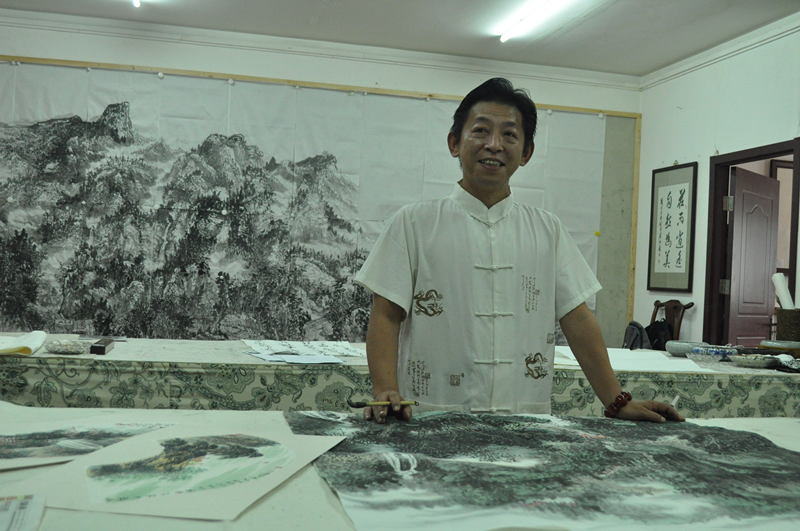
多年来刘伟的写生足迹踏遍了中国的半壁江山。黄山的云霧面纱,三清山的冷峻清秀,丽江的水,潇湘的竹,雁荡山的寺庙,鄱阳湖的鱼舟都曾访问过刘伟的写生画稿。大量的写生创作使刘伟的画作摆脱了古人语言束缚,注意整体感觉与局部趣味关系和宏观驾驭整体态势,而不拘于一点一划的完美无瑕。从此刘伟的作品便趋向成熟,而形成了自己的风格。
Over the years, Liu Wei's sketching footprints have covered half of China. Liu Wei's sketches have been visited by the clouds and mists of Huangshan, the coldness and beauty of Sanqing mountain, the water of Lijiang, the bamboo of Xiaoxiang, the temples of Yandang Mountain and the fish boat of Poyang Lake. A large number of sketching made Liu Wei's paintings get rid of the shackles of the ancient language, pay attention to the relationship between the overall feeling and local interest and macro control of the overall situation, and do not confine to the perfection of one stroke at a time. Since then, Liu Wei's works tend to mature and form their own style.
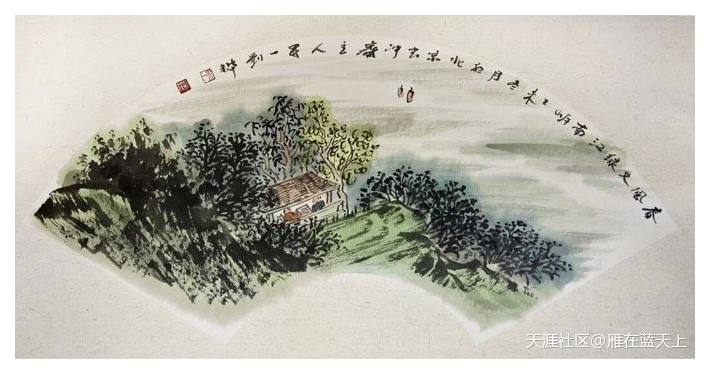
刘伟的小品画作《春风又绿》
Liu Chunfeng's painting "Liu Chunfeng"
刘伟除泰山系列作品的磅礴大气外,山水小品也都在尺幅之间有浓缩天地之感。他的“春、夏、秋、冬”四条屏,构图严谨,用笔简练,着色不多而四季分明。《团扇》是他尝试用古人的技法表现现代山水的作品。那虬曲弯盘的古树,激涌奔流的泉水,桥上独行的老人分明给人一种恬淡宁静生态之感。令人净化灵魂而心生向往。
In addition to the majestic atmosphere of Mount Tai's series of works, Liu Wei's landscape sketches also have a sense of concentration between the scales. His "spring, summer, autumn, winter" four screens, the composition of rigorous, concise pen, not much coloring and four distinct seasons. "Tuan fan" is a work that he tried to use the ancient techniques to express the modern landscape. The winding ancient trees, surging springs, and the old people walking alone on the bridge clearly give people a sense of tranquility and tranquility. It makes people yearn for purifying the soul.
最被评论家关注的作品还应是《山东日出》。雄伟的山脉,蒼郁的青松,奔涌的溪水,喷薄的红日这些物象语言无不在激发观众对祖国山河的热爱和蓬勃向上的激情。
The most concerned work should be Shandong sunrise. Majestic mountains, lush green pines, rushing streams, gushing red sun, all of these physical language stimulate the audience's love for the motherland's mountains and rivers and vigorous passion.
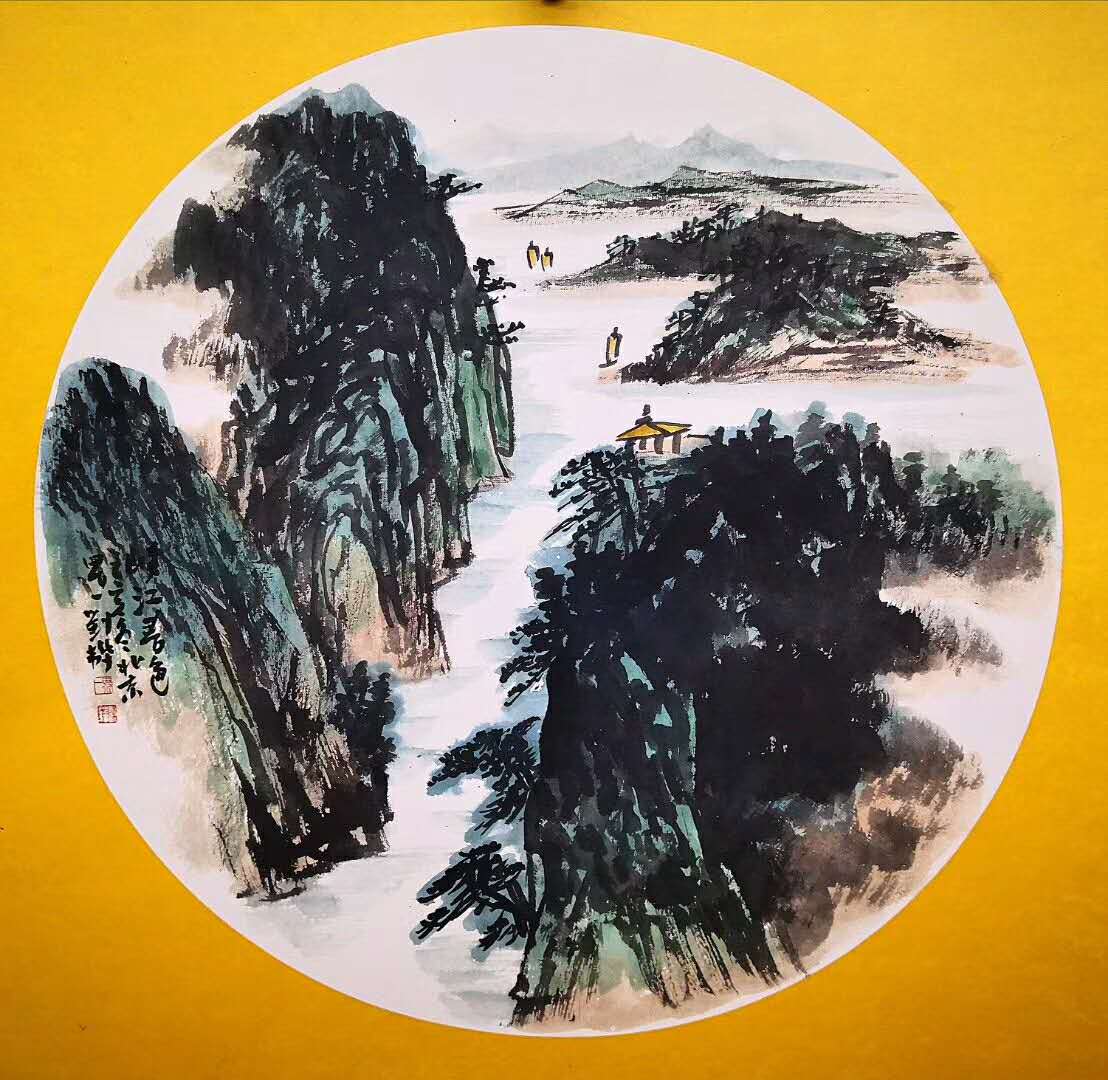
读刘伟的作品有一个特点,凡山都有涓涓清流从大山深处逶迤而来。刘伟解释,水乃生命之本,山高水长,然后草树兴旺,给人以生机。
There is a characteristic in reading Liu Wei's works. Every mountain has a trickle of clear water flowing from the depths of the mountains. Liu Wei explained that water is the foundation of life. The mountains are high and the water is long, and then the grass and trees flourish to give people vitality.
上善若水,与世无争也正是刘伟的性格。 看刘伟的山水作品,能体会到儒家的仁德,道家的空灵和佛家的禅意。而这些意境都来自于几千年齐鲁文化对他的熏陶和儒、释、道三教对他的影响。他要通过自己的画笔从更多的层面表现出中国山水的雄伟、仁厚、柔美与含蓄。 刘伟胸怀着天地,他笔下的山川也就有了灵气。
It is Liu Wei's character that he is as good as water and indifferent to the world. Looking at Liu Wei's landscape works, we can feel the benevolence of Confucianism, the ethereal spirit of Taoism and the Zen of Buddhism. These artistic conception comes from the influence of Qilu culture for thousands of years and the influence of Confucianism, Buddhism and Taoism on him. He wants to show the grandeur, benevolence, softness and implicitness of Chinese landscape from more aspects through his own brush. Liu Wei's heart is full of heaven and earth, and the mountains and rivers in his works also have aura.
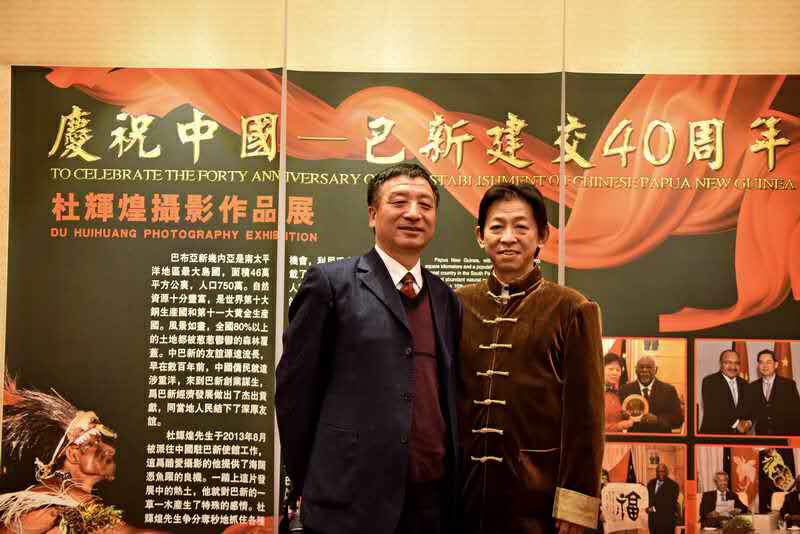
▲本文作者与画家刘伟在钓鱼台国宾馆
The author and painter Liu Wei are in Diaoyutai State Guesthouse
郝连成采写于北京 2016年7月
Hao Liancheng wrote in Beijing in July 2016


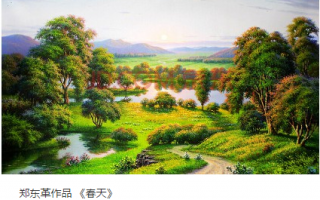

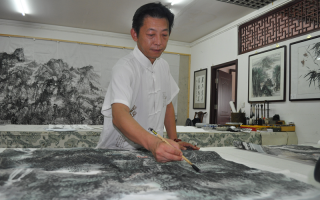
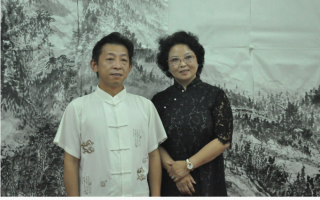

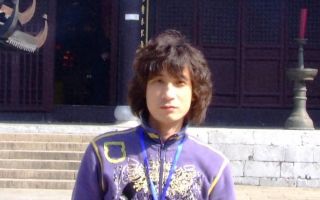
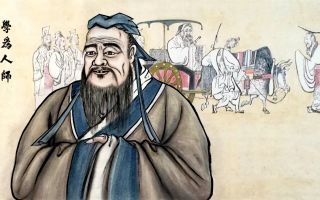
0 条 评 论 Write a Response